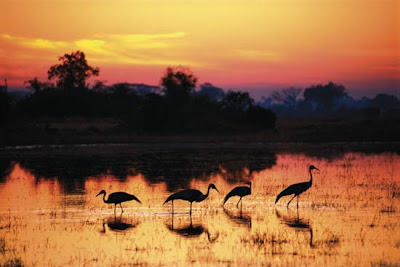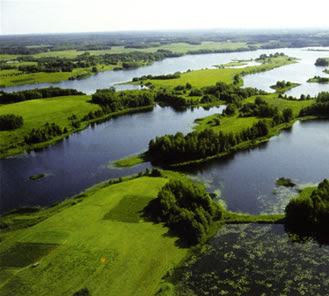Askania-Nova : UKRAINE
Askania-Nova is a biosphere reserve in Kherson Oblast, Ukraine, located within the dry Tavriya steppe. The natural reserve was established in 1874 by landowner Friedrich Eduardovych Falz-Fein around the German settlement Askania-Nova . The reserve consists of the acclimatization zoo, botanical garden (2.1 km²), and a virgin steppe preserve (110 km²), and has total area of 825 km². The reserve consists of the acclimatization zoo, botanical garden (2.1 km², or 518.9 acre), and virgin steppe preserve (110 km², or 42.5 sq mi), the last such area in Europe) and has total area of 825 km² (318.5 sq mi). In addition to local species it hosts ostriches, bisons, antelopes, wild horses, llamas, zebras and many bird species. More than 200 species of foliaceous and coniferous plants were brought from different parts of the world and planted in the dendrologic garden during 1885 - 1902. About 600 higher plants (both perennial and annual), 16 species of which were entered to the Red Data Book of Ukraine, have been preserved in their primary natural form. The reserve is known for the group of Przewalski's Horse, the largest group kept in captivity, living on area around 30 km² (11.5 sq mi). Today's official name of the reserve is Інститут тваринництва степових районів ім. М.Ф. Іванова "Асканія-Нова" ("Institute of Steppe Animal Farming Askania-Nova"). In 2008, Askania was named one of 7 Natural wonders of Ukraine. The reserve became the only Ukrainian national nominee in the New7wonders of Nature campaign (group E - Forests, National Parks, Natural reservs).

The reserve consists of the acclimatization zoo, botanical garden (2.1 km², or 518.9 acre), and virgin steppe preserve (110 km², or 42.5 sq mi), the last such area in Europe) and has total area of 825 km² (318.5 sq mi). In addition to local species it hosts ostriches, bisons, antelopes, wild horses, llamas, zebras and many bird species. More than 200 species of foliaceous and coniferous plants were brought from different parts of the world and planted in the dendrologic garden during 1885 - 1902. About 600 higher plants (both perennial and annual), 16 species of which were entered to the Red Data Book of Ukraine, have been preserved in their primary natural form. The reserve is known for the group of Przewalski's Horse, the largest group kept in captivity, living on area around 30 km² (11.5 sq mi). Today's official name of the reserve is Інститут тваринництва степових районів ім. М.Ф. Іванова "Асканія-Нова" ("Institute of Steppe Animal Farming Askania-Nova"). In 2008, Askania was named one of 7 Natural wonders of Ukraine. The reserve became the only Ukrainian national nominee in the New7wonders of Nature campaign (group E - Forests, National Parks, Natural reservs).Today this reservation is the highlight of the Kherson region for numerous tourists who travel across the south of Ukraine. And it all began from the hobby of ten-year-old Friedrich: breeding local birds in aviaries he received as a gift from his father. Some people considered Friedrich Falz-Fein a strange person for his “non-commercial” interests, but the international scientific community called him “the Askanian Darwin” and “the first ecologist”. After visiting dozens of zoos and botanical gardens around the world, he implemented the newest techniques of animal breeding. To carry on his experiments, he consulted with leading scientists on the selection of domestic animals, as well as acclimatisation and breeding of rare species. By that time, his park was the third-largest private zoo in Europe, after those in London and Amsterdam. At the end of the 19th century, the Askania-Nova zoo hosted 208 species of birds and 52 species of ungulates from Eurasia, Africa, the Americas and Australia. Friedrich Falz-Fein built his collection over 42 years, increasing the number of species every year until 1916. Today, the oldest heir of the family is a nephew of the founder of the Askania-Nova reserve: Eduard Oleksandrovych Falz-Fein (born in 1912), in his time a famous sportsman, journalist and businessman. Since 1936, he is a subject of the Lichtenstein principality, where he resides now in the Askania-Nova villa. Baron Falz-Fein is one of the few sponsors who supports the reserve financially and morally, at the same time restoring historic justice about the works of his great predecessor.

Biosphere Reserve Askania Nova - a unique corner of nature: here is the only station in Europe steppes, who had never dealt with the plough (once excavated will not be restored steppe). Reserve Nova Kakhovka assigned to "100 great reserves and parks" Peace same book, published in Moscow publishing house "Veche" in 2002 (author-originator Yudina NA). Museum under the open sky: here alone preserved ancient burial mounds, stone Scythian women, created by ancient sculptor. The reserve covers an area of 11 thousand ha.; adjoins the forest park with artificial ponds and canals, where inhabit many animals and birds. In Askaniyskoy steppes more than 400 species of herbs and flowers, cereals dominate. In late April start tulips bloom, then irises, astragalus, hyacinth, lyutiki. In May - carnations, daisies. In summer steppe, muffled in the fir haze kovylya, transfused waves from the slightest breeze blow. Askaniysky park covering about 200 hectares. It differs from the wild steppe zone. It is divided according to a strict plan. The park about 150 kinds and forms of trees and bushes. Ilex maple, Crimean pine, pyramidal and kolonnovidny oaks, juniper, elm, spruce, ash, white acacia, near water - weeping willows. Centre songs Park - a picturesque pond.

Askania-Nova is a biosphere reserve in Kherson Oblast, Ukraine, located within the dry Tavriya steppe. The natural reserve was established in 1874 by landowner Friedrich Eduardovych Falz-Fein around the German settlement Askania-Nova . The reserve consists of the acclimatization zoo, botanical garden (2.1 km²), and a virgin steppe preserve (110 km²), and has total area of 825 km². The reserve consists of the acclimatization zoo, botanical garden (2.1 km², or 518.9 acre), and virgin steppe preserve (110 km², or 42.5 sq mi), the last such area in Europe) and has total area of 825 km² (318.5 sq mi). In addition to local species it hosts ostriches, bisons, antelopes, wild horses, llamas, zebras and many bird species. More than 200 species of foliaceous and coniferous plants were brought from different parts of the world and planted in the dendrologic garden during 1885 - 1902. About 600 higher plants (both perennial and annual), 16 species of which were entered to the Red Data Book of Ukraine, have been preserved in their primary natural form. The reserve is known for the group of Przewalski's Horse, the largest group kept in captivity, living on area around 30 km² (11.5 sq mi). Today's official name of the reserve is Інститут тваринництва степових районів ім. М.Ф. Іванова "Асканія-Нова" ("Institute of Steppe Animal Farming Askania-Nova"). In 2008, Askania was named one of 7 Natural wonders of Ukraine. The reserve became the only Ukrainian national nominee in the New7wonders of Nature campaign (group E - Forests, National Parks, Natural reservs).

The reserve consists of the acclimatization zoo, botanical garden (2.1 km², or 518.9 acre), and virgin steppe preserve (110 km², or 42.5 sq mi), the last such area in Europe) and has total area of 825 km² (318.5 sq mi). In addition to local species it hosts ostriches, bisons, antelopes, wild horses, llamas, zebras and many bird species. More than 200 species of foliaceous and coniferous plants were brought from different parts of the world and planted in the dendrologic garden during 1885 - 1902. About 600 higher plants (both perennial and annual), 16 species of which were entered to the Red Data Book of Ukraine, have been preserved in their primary natural form. The reserve is known for the group of Przewalski's Horse, the largest group kept in captivity, living on area around 30 km² (11.5 sq mi). Today's official name of the reserve is Інститут тваринництва степових районів ім. М.Ф. Іванова "Асканія-Нова" ("Institute of Steppe Animal Farming Askania-Nova"). In 2008, Askania was named one of 7 Natural wonders of Ukraine. The reserve became the only Ukrainian national nominee in the New7wonders of Nature campaign (group E - Forests, National Parks, Natural reservs).Today this reservation is the highlight of the Kherson region for numerous tourists who travel across the south of Ukraine. And it all began from the hobby of ten-year-old Friedrich: breeding local birds in aviaries he received as a gift from his father. Some people considered Friedrich Falz-Fein a strange person for his “non-commercial” interests, but the international scientific community called him “the Askanian Darwin” and “the first ecologist”. After visiting dozens of zoos and botanical gardens around the world, he implemented the newest techniques of animal breeding. To carry on his experiments, he consulted with leading scientists on the selection of domestic animals, as well as acclimatisation and breeding of rare species. By that time, his park was the third-largest private zoo in Europe, after those in London and Amsterdam. At the end of the 19th century, the Askania-Nova zoo hosted 208 species of birds and 52 species of ungulates from Eurasia, Africa, the Americas and Australia. Friedrich Falz-Fein built his collection over 42 years, increasing the number of species every year until 1916. Today, the oldest heir of the family is a nephew of the founder of the Askania-Nova reserve: Eduard Oleksandrovych Falz-Fein (born in 1912), in his time a famous sportsman, journalist and businessman. Since 1936, he is a subject of the Lichtenstein principality, where he resides now in the Askania-Nova villa. Baron Falz-Fein is one of the few sponsors who supports the reserve financially and morally, at the same time restoring historic justice about the works of his great predecessor.

Biosphere Reserve Askania Nova - a unique corner of nature: here is the only station in Europe steppes, who had never dealt with the plough (once excavated will not be restored steppe). Reserve Nova Kakhovka assigned to "100 great reserves and parks" Peace same book, published in Moscow publishing house "Veche" in 2002 (author-originator Yudina NA). Museum under the open sky: here alone preserved ancient burial mounds, stone Scythian women, created by ancient sculptor. The reserve covers an area of 11 thousand ha.; adjoins the forest park with artificial ponds and canals, where inhabit many animals and birds. In Askaniyskoy steppes more than 400 species of herbs and flowers, cereals dominate. In late April start tulips bloom, then irises, astragalus, hyacinth, lyutiki. In May - carnations, daisies. In summer steppe, muffled in the fir haze kovylya, transfused waves from the slightest breeze blow. Askaniysky park covering about 200 hectares. It differs from the wild steppe zone. It is divided according to a strict plan. The park about 150 kinds and forms of trees and bushes. Ilex maple, Crimean pine, pyramidal and kolonnovidny oaks, juniper, elm, spruce, ash, white acacia, near water - weeping willows. Centre songs Park - a picturesque pond.














































